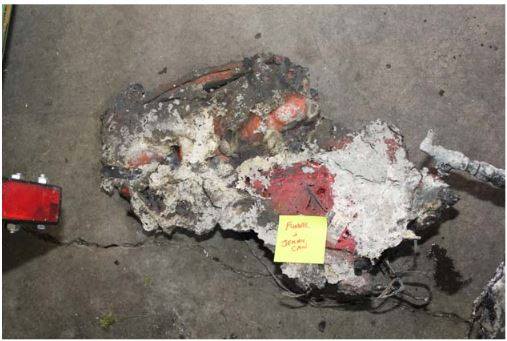It was something technician Ryan Brown had done thousands of times over years, pouring fuel, but on that December day in 2016 it went horribly wrong.
The owner of Ryan Brown Performance in Strathmore, Alta., Brown (pictured above before the accident) picks up the story:
“I was pouring fuel (pump gas, which means gasoline that you would purchase at the local gas station pumps) from a plastic fuel jug thru a large plastic filtered funnel, into the dyno room fuel cell. Something I’ve done literally thousands of times over the last 18 years. It was very cold (-25 C) and dry that night. All fuel jugs are kept outside, so I brought one into the dyno cell area (with ventilation on) and began pouring the fuel into the funnel. A minute or so in, and the fuel started to back up about 1/3 of the way up the funnel, and since I did not want to continue filling, I lifted the fuel jug off the funnel, and at that point the explosion happened.”
Brown was immediately engulfed in fire, struggling to breathe and fighting for his life.
“The next thing I knew, my face was on fire, and when I looked out, all I could see was flames seemingly on my eyeballs. I could breathe a bit, but I could feel the extreme heat in my mouth from the flames on my face and my lips when starting to inhale, so I held my breath while exiting the shop and luckily found a snow bank to dive into head first, mouth open.”

Following the accident surrounded by family, Ryan Brown’s family is clearly happy to still have him.
The interior of the shop was ablaze and once help arrived, he was flown to the Foothills Hospital in Calgary, Alta. with third degree burns to his head, face and the left side of his upper torso.
And in case readers might think otherwise, this is still very much in the present for Brown.His most recent surgery was scheduled for February 16, just the latest of more surgeries over the past year than he cares to count with more to come. He has had some time to think about the cause of the accident.
“The theory is that the flowing fuel was building a static charge in the fuel jug and (since the jug was resting on it) the funnel. When I lifted the jug off the funnel, there was a static discharge. The vapor atop the fuel in the funnel was in a combustible zone, and it ignited. It is hard to convey just how instantaneous this is. You have zero time to react. I don’t think I can over state this fact. You’ll just have to trust me on this one.”
“No matter if you deal with fuel or not, I would like everyone to read this, absorb it, then share it to as many people as possible.”
What he’s learned
He has spent time learning about his accident in the hopes that others might gain from his experience and avoid a similar fate.
“These are active topics and should not be used as a definitive guide,” says Brown. They are the product of research and conversations that are ongoing:
1 – I always strive for clean fuel, and once you use a funnel with a fine filter screen, you can see how dirty the inside of fuel jugs can be. The fuel was stored outside, and because it was well below freezing, whatever condensation in the pump gas was frozen into tiny particles of ice. As I was pouring the fuel into the funnel, the ultra fine screen collected the ice/slush, slowing down the flow of fuel. I am confident that if the funnel I was using was not filtered, this would not have happened. The fuel would have been out of the funnel when the jug was lifted off, therefore the vapour would not have been in a combustible zone when the discharge happened. In fact, I strongly believe that this discharge happens far more frequently than we realize. The difference is that without something slowing the flow of fuel thru the funnel, the fuel is usually long gone. I’m not entirely sure how I will be keeping the fuel cell clean (with the lack of a filter in the funnel) in the future.
2 – With insight from local karting club CKRC manager (Fred Causer) if using a plastic fuel jug, use a metal funnel, and vice versa. This was something Fred learned in his military background with the Royal Air Force.
3 – One good thing was that I had on my trusty Mechanix Wear gloves, and my hands were unscathed. I would however recommend wearing some sort of clear face shield, if even to keep any errant splashes out of the eyes.
4 – When pouring fuel, keeping the sloshing down to a minimum will reduce vapour.
5 – Grounding cables. This is a fluid topic. Some say using low resistance grounding / bonding on plastic containers is just fooling ourselves. If it was essential, it would be nice if the fuel jug companies gave us some material on the jug to attach permanent grounding cables, maybe some do? I’ve looked over mine and they don’t. Coupling the jug to the funnel, then to the cell. Do we need a grounding rod also? I get vastly different suggestions from different professionals I have talked to in that field.”
Looking ahead
Brown is looking to continue his work to ensure a safer future.
“If you know someone in the field that can enlighten me, send them my way. I am usually the one in the group who is looking for the dangers and taking steps to avoid them. I missed the boat here. I do feel that getting the word out to as many people as possible, giving them a slight bit of insight into how life can change in an instant, may save someone, somewhere. I am notably scarred for life. More surgeries are in the near future, and laser treatments for years to come.
“I went to physio 5 days a week for 10 months and one day while walking up a long hill towards the rehab gym I was lamenting in the thought that all of this has happened, life has been turned upside down for a split second lapse, just one moment.
“Oh, how I wish I could have that moment back. Be safe.”
Anyone wishing to get in touch with Ryan Brown can reach him at rbperf@hotmail.com.
Special thanks to Zara Wishloff at APD Auto Parts Distributors for bringing Ryan’s story to our attention.


0 Comments